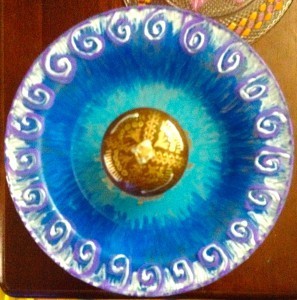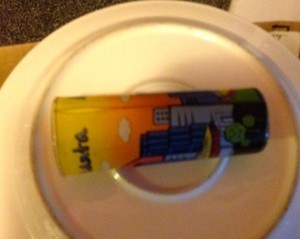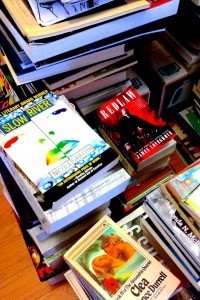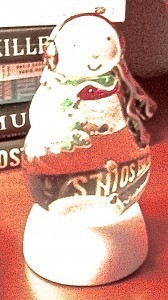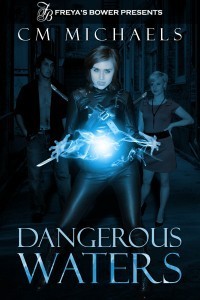Cat Rambo's Blog, page 67
December 31, 2013
Goodbye, Jitters
Silver and gold balloons adorn the Jitters exterior. They've been around 22 years!
Today was a mournful day. Every morning I go grab coffee at a local coffee shop called Jitters, which has been around Redmond much longer than I have: 22 years to my 14. But now they’ve had to close their location (a repurposed bank building) and haven’t been able to find a new place.They’re celebrating their last day in style: balloons, a big card for everyone to sign, and free coffee all day long, but there is a sad undertone to the merriment. We’d gone through the drivethrough, then came in to sign the card and say goodbye. Last week, I’d made sure to sign up for the mailing list, to be notified if they find a new location, but so far the manager hasn’t seemed very hopeful about that.
As we were coming towards the door, a gentleman was coming out. We nodded at each other and he paused. Both of us felt, I think, a need to mark the occasion, to acknowledge the Jitters bond. “Sad day,” he said. “Very sad,” I replied. Inside all the baristas were glammed out and a little shell-shocked, I think, that this day had come.
This is my new lifestyle. It's more solitary yet stylish. The dragon mug is from my crazy aunt.
Meanwhile, I’ve bought a lovely Chemex in order to make coffee at home after reading a recent Chuck Wendig post about it. I fear that I finally have fallen into the Seattle trap and become a coffee snob. I even have some Tonx coffee coming, since they are willing to give you a free sample. And there’s a pleasing ritual to it, the dousing of the filter in hot water, then using that water to warm the mug. Wayne got me an electric kettle for Christmas after watching the two saucepan version of that dance, and it rocks.Still, I will sorely miss Wendy and Megan and Amanda and all the rest of the cheerful Jitters crew.
December 30, 2013
Online Classes: Buy 2 Get 1 Free Class Offer Ends at Midnight
Classes, which include writing workshops and classes on editing, podcasting, and creating an online presence are taught online. You can participate via webcam or audio-only. They are small (limited to 8-9 students) and focus on getting you writing and submitting fiction with an active, engaging instructor.
Please spread the word, particularly if you’ve taken a class with me before. This is a reminder that you’ve got two more days to take advantage of this end of the year offer, which expires at the moment we move from 2013 to 2014.Sign up for two single-session classes ($99 each, $89 each for former students) and get a third one free.
OR
Sign up for the Writing F&SF Short Stories class or Advanced Story Workshop ($199) and get a single-session workshop free.
Why take one of these? Here’s some testimonials from former students.
To sign up, mail me at catrambo AT gmail.com and indicate which classes you’re interested in and whether you would prefer to pay via Paypal or check.
Upcoming classes include the six week workshops Writing Fantasy & Science Fiction and Advanced Workshop and these one day workshops: Building an Online Presence for Writers, Character Building, Editing 101, First Pages Workshop, Flash Fiction Workshop, Literary Techniques for Genre Fiction, Moving Your Story from Idea to Finished Draft, and Podcasting 101. See here for dates.
Online Classes: Two More Days for Buy 2 Get 1 Free Class Offer
Classes, which include writing workshops and classes on editing, podcasting, and creating an online presence are taught online. You can participate via webcam or audio-only. They are small (limited to 8-9 students) and focus on getting you writing and submitting fiction with an active, engaging instructor.
Please spread the word, particularly if you’ve taken a class with me before. This is a reminder that you’ve got two more days to take advantage of this end of the year offer, which expires at the moment we move from 2013 to 2014.Sign up for two single-session classes ($99 each, $89 each for former students) and get a third one free.
OR
Sign up for the Writing F&SF Short Stories class or Advanced Story Workshop ($199) and get a single-session workshop free.
Why take one of these? Here’s some testimonials from former students.
To sign up, mail me at catrambo AT gmail.com and indicate which classes you’re interested in and whether you would prefer to pay via Paypal or check.
Upcoming classes include the six week workshops Writing Fantasy & Science Fiction and Advanced Workshop and these one day workshops: Building an Online Presence for Writers, Character Building, Editing 101, First Pages Workshop, Flash Fiction Workshop, Literary Techniques for Genre Fiction, Moving Your Story from Idea to Finished Draft, and Podcasting 101. See here for dates.
December 28, 2013
Creating Glass Garden Flowers: A Walkthrough
At least a glass saucer or plate will get added to this project as "petals," but the painting part of the process is pretty much done. I've used both sides of the plate in order to create additional depth. The center piece is a wooden stopper for a long-ago broken decanter. It's decorated with metallic paint pen. I'll finish it off with a layer of something to water-proof it. I was pleased with the look of it overall, though.
When I set out to make the glass garden flowers for Mom, I found plenty of pictures but very few tutorials. So here’s a walkthrough of the process, which should illustrate one important thing about these: they’re not a last minute project. The paint takes time to dry, as does the adhesive, which you will need to do in at least two stages.What you need:
Glass or ceramic pieces to make the body of the flower from
Shot glass or small bottle to form back of flower
Marine Goop – marine adhesive
Glass/ceramic paint and brushes (optional)
3 to 5′ (suggested) length of rebar or other stake-like material
Terrycloth
Duct tape
Step 1: Assemble What You Have
Assemble the glassware you’ll be using. I suggest checking cupboards first. You’ll want several sizes that can be layered on top of each other, and (usually, depending on your other pieces) something for the center, like a short candlestick, round glass ball, or other object suitable for a focal point.
Go through your crafting supplies and look for beads, bits of jewelry, beach glass, shells, and other pieces that can be used to decorate layers.
Look at what some people have done to get ideas.
Step 2: Find What You Don’t Have
If you can’t find everything you need at home, go shopping. In the thrift store, look for interesting pieces that are chipped or otherwise deeply discounted in both the ceramics and glassware sections. Check the metalware and mirrors as well. My local Value Village has a wall in which they bag oddments and sell as lots. If you have this, browse through it. Things you’re looking for: glass pebbles, large beads, holiday ornaments, mosaic pieces, and other things that can be glued onto plates. Pick up old shot glasses or small bottles to use for the backs.
I prefer to let what I find dictate the piece. You can also try to replicate or improve on an existing pattern or otherwise plan it out. In such a case you may need to visit multiple stores to find what you need.
In the dollar store, look for glassware and remember that you are able to paint it.
Step 3: Figure out the Layers
Bring home the pieces and arrange them, trying to figure out the order in which you will want to glue them. You may choose to work from the front to the back or vice versa. Attaching the shot glass will be a final step.
Step 4 (optional): Paint Glass
Decide if you’re going to paint the glass, which must be finished before any gluing can take place. If so, I used DecoArt Gloss Enamels, which can be used on wood, glass, and ceramics. Be aware painting add time to the process. You will paint the piece in stages, letting each color dry in turn, and then letting the overall piece dry for four days before you bake it to set the colors. Is it worth it? Here’s another of the pieces I painted today.
This plate will serve as the back layer of a flower. I suggest not worrying too much about being meticulous with the paint. You want an organic feel for the flower (in my opinion). I'll let this piece dry and then bake it to set the colors before I start adding anything to it. Because pieces will overlap the center, there's no point in getting too elaborate with it.
Once you have painted the glass, let it dry and bake it.
Step 5: Glue the Layers
Once the step involving glass paint has been performed or skipped, you can begin gluing. I suggest putting down the back piece, gluing the next layer atop it, etc. You can assemble all the front layers and glue them. Set to dry on a level, ventilated surface that is reasonably warm. Let them dry at least 24 hours.
Step 6: Decorate the Layers
At this stage you may glue other things in as decoration. Among what I’ve used so far: Christmas ornaments, gold foil, a cat toy, glass flowers, marbles, large pearl beads, glass pebbles. Let dry at least 24 hours.
Step 7: Add the Back
Now you’re ready to add the back. I use a plastic cereal container to hold the pieces while gluing on the backing, since many of them have delicate front pieces that they cannot rest on. Again let the piece glue for at least 24 hours.
Step 8: Assemble the Stake or Holder
To assemble the holder, if using a shot glass, cut a small piece of terrycloth and duct tape it to the top of the rebar. You can adjust it to make it fit snugly into the glass. Otherwise, you do not need to pad the rebar.
Finito. Now you know enough to make more and probably new ideas have occurred to you already. I’d love to see your creations, please post links if you have them!
December 27, 2013
Getting Ready for 2014: One Method of Decluttering
I have a photo of this fabulous object, a clown teapot with cups shaped like clown heads, each with xes for eyes, as though the principal clown had slain all his enemies and taken their severed heads in the process. Therefore it's okay I didn't buy it. Someone else gets all the joy.
We’ve (as in two humans, two cats, a briefly lived betta, and assorted temporary insects) lived in this space since 2001. While I’ve decluttered and cleaned before, cruft inevitably creeps in. An odd little ball colored red, white, and blue. Countless keys. Sharpies in a rainbow of colors. Twists and ties and clips. Twenty years after my D&D days, there’s still a few polyhedrals rolling around.Many things have memories attached, and discarding the object sometimes feels like discarding the memory. The paperweight I bought in Prague while traveling to train Eastern Europeans about network security software. A tin butterfly from our time in Mexico when I was a child. The sequinned baby shoes I use as a prop in the flash class. I feel as though if I put them aside I may lose the thing that triggers the memory.
While I’m not ditching everything, a lot of these are getting digitized. I take a few pictures with my camera and stick it aside. Here’s an example of a book I’ve been carrying around since high days. My paternal grandmother got it for me when I expressed an interest in folk tales and folk songs. I drew on it heavily when writing songs for Armageddon, sometimes adapting songs outright, otherwise creating ones patterned after the originals.
It’s a hefty doorstop of a book. I suspect I’ll be able to find this knowledge, or comparable stuff, on the net whenever I need to. But at the same time, the object holds memories: sitting in my room in high school, reading through it, while the rain drummed on the roof and the locust tree outside my window tapped its long fingers on the glass, for one. Performing songs based on it as my bard on Armageddon, purple-haired, seemingly bemused but secretly sharp, Karaluvian Fale. I take more than just a photo of the dustjacket: one of the inside so I can see the font, another of an illustration, one of an enigmatic and very scrawly note. Enough that I’ll be able to evoke it, access those memories again if I want to.
What’s the best way to preserve these images? I haven’t gotten that far yet. For now I’m saving and tagging, and trying to shrink down the mass of physical stuff attached to my life.
Unwritten Creativity: Glass Garden Flowers For Mom
How to make the mounts for these recycled glass flowers is a detail that most of the Pinterest pins don't seem to answer. I used a tall shot glass, affixed with marine adhesive. I didn't want a short shot glass because it seemed to me those would be tippier.
One of Mom’s presents this year was a set of garden flowers made from odd plates and dishes. These were a lot of fun to assemble, and I want to, over the course of the next few months, make a set that goes across the problematically shady front section of her house. Combined with the tulips and irises, that should fill things out and add both color and a touch of individuality.I’d gotten the idea from seeing them on Pinterest. I did do some picking through thrift stores to find odd bits of china, but also used some pieces I’d gathered over the years. It seemed like a nice way to carry out the decluttering mission, but preserve some of those memories. I augmented some pieces with glass or metallic spray paint and glued on glass pebbles, marbles, and other odd bits. The fixative for all of this is Marine Goop, which you can find on Amazon.
If I had more workspace, I might employ the Dremel in some of this, by drilling holes in things and then using a screw and bolt to hold the constructions together. However, the glue is marine fixative that is super strong and waterproof. I’m going over to Mom’s tomorrow to get some of the flowers set up and that will be the first test.
Tips for creating glass/china garden flowers:
Glue in stages and let them dry completely. Gluing the shot glass (or bottle) on the back will probably be the last thing you do. I used plastic containers to hold the flowers upside while the shotglass set.
Give yourself plenty of time. That glass paint is supposed to dry for four days before you set it by baking it. I may have shortened that a bit in my rush and it remains to be seen what the result is.
Don’t be afraid to adorn. I glued on glass charms and pebbles, gold candy paper, pearl beads, and a cat toy.
Keep it on the cheap by a) seeing what you have already in cupboards and crafting supply boxes that can be sued, b) checking when thrift stores have their china and glassware on sale, and c) looking for chipped items that are discounted further.
Don’t just look at china and glassware. I used chipped Christmas ornaments, a ceramic garden pot spray-painted copper, and a metal serving plate. Next time I’m thrifting I’ll look for round mirrors as well. One great example I saw used old knives arranged like spikes around the outer edge.
The Pinterest versions suggested gluing bottles to the back, but that seemed very large to me given the size of the flowers. Instead I used tall shot glasses, which run fifty cents each at our local Goodwill. The mounts are lengths of rebar capped with a padded top made of terrycloth from a cut-up towel and duct tape.
As a writer, I think it’s important to be creative in other ways. I cook, I garden, and sometimes I make things. Usually I give those things away because otherwise I would drown in objects. The flowers were a fun way to exercise that urge to make, and somewhere down the line I’ll be doing flash stories to go with each one. In the meantime, I’ve written the titles for those already.
I’ll go through the individual ones in posts. Here’s the first.
This is "Snow Queen." Layers, back to front, are: a cut glass plate, willow ware plate, floral saucer with glass marbles and beads, vintage ice ice cream glass, a Christmas ornament, large pearl beads.
I think this ornament is a reasonable example of preserving memories. The ice cream glass is part of a set acquired several decades ago. I have a poem about willow ware, so I like using it. The glass charms are part of a hanging ornament that I received several years ago, and I’ve had the marbles since high school.
The pearl beads evident in the "in the wild" shot are lacking here. One important step in making these is, once you've finished, eyeball them and see how happy you are with the result. I wanted another echo of the elegance implicit in the ornament's shape, so I found the beads in digging through my craft box and incorporated them. There are also opalescent beads trapped in the glass beneath the ornament.
December 23, 2013
Getting Ready for 2014: On Going Through My Books
Here's some of the books, stacked in the hallway and waiting to be sorted through. It's a fairly representative sampling. Redlaw was picked up at a con; it's a good thriller reminiscent of Paul Cornell's London Calling. Nicola Griffith's Slow River is a book I hate to part with and I know there's a good chance I might reread it at some point but for now...out it goes. There's some issues of the Magazine of F&SF, and Lawrence Durrell's Clea, which was part of "I will improve myself as a writer" reading.
One of the things 2014 is bringing is all sorts of interesting and awesome changes, but part of that is a need to trim down drastically. So I’ve been going through my books getting ready to sell a lot of them. Many are from teen years, college, or grad school. Others are gathered at cons, sometimes with stories attached. Some sparked stories, or were gifts from, or were written by people I respect and admire and sometimes love. Some are signed. Some have notes jotted in them. Some are books that changed my life.So far I’ve winnowed 700 or 800 books from the collection and there’s still a lot left. Not to mention there’s a storage locker holding at least another 1000. Argh.
But rather than dump them all at Value Village, I’m taking these last days to sort through them. Because some of these books are old, old friends. So I’m checking them on Amazon (and finding a few worth unexpectedly more, which is nice) and listing all the ones for sale in a spreadsheet, with a few notes and a price. A few I’m putting aside to give to specific people. There’s two boxes laid aside already for my godchildren.
My plan with the ones for sale is to give my two best friends, my brother, and my mom first crack to see if there’s any they want. (Or any that are actually already theirs, in mom’s case, since the boundary between my mom’s books and mine has been pretty fluid from time to time.)
After that, time to see if I can get a little filthy lucre for them. I’ll offer to share the spreadsheet with my writing group, students, other friends, and anyone else interested. (Drop a line here if you are.) Lots of fiction, particularly short stories, a lot of Women’s Studies texts, assorted odd bits and interesting historical stuff. The usual round of books about writing.
I’ll be blogging about some of the books as I hit them. After this comes a similar pass at all the knick-knackery I have accumulated. Not looking forward to that too much, but there’s also a good feeling, a wind-through-one’s-soul feeling that comes with shedding stuff.
I’ll keep you posted.
December 20, 2013
Five (More) Gifts for Speculative Fiction Writers
Often thinking what you might like will lead to a present another person will enjoy. You do want to take their tastes and needs into account, though - don't buy your lactose intolerant friend a big bar of chocolate!
A couple of days, I blogged with five gifts for speculative fiction writers. Here’s an additional five, which you can get in time for the holidays still.Help them exercise their creativity. Provide them with clay, paints, fabric, glitter glue, sketchbooks, pens of magnificent and splendid color. Try Daniel Smith or the U. Bookstore for great selections.
A donation in their name to an appropriate charity. I like Heifer.org, Kids Need to Read, and Kiva.
For the power traveler perpetually on publicity tour, an Aerotray, a solar phone charger, a Tom Bihn bag, or a set of GoGear travel bottles.
Time. Either spend some time with them (take them out for lunch, dinner, to the zoo, up in a balloon, out for coffee and chat, on a cruise) or save them some time (sign them up for a delivery service, offer to baby-sit, help out with errands or household work). Or offer them proof-reading/copy-editing time.
Learning, via a gift certificate for my online classes. Right now through January 1st, 2014, mention this post on social media or in a blog (or spread the word some other way) and you’re entitled to a special deal. Buy two, get one free (one day workshops only) OR enroll in Writing F&SF or Advanced and get a free one day workshop.
Upcoming classes include the six week workshops Writing Fantasy & Science Fiction and Advanced Workshop and these one day workshops: Building an Online Presence for Writers, Character Building, Editing 101, First Pages Workshop, Flash Fiction Workshop, Literary Techniques for Genre Fiction, Moving Your Story from Idea to Finished Draft, and Podcasting 101. See here for dates.
December 17, 2013
Five Gifts for Speculative Fiction Writers
Other gift possibilities: a gift certificate to your local indy bookstore, pens (I like fountain pens a lot), and fuzzy socks to keep their toes warm while writing.
Here’s five gifts for the writer on your list (even if it’s yourself).A little history. One of my favorite reads this year was Bud Webster’s Past Masters: And Other Bookish Natterings. Bud’s book combines hearty doses of interesting history with some deliciously thorough reading lists, that will only lead you to more and more reading. Bud always managed to tell me something about the writers that I didn’t know but which shed more light (and interest) on the stories I already loved. Heartily recommended, particularly if you’re well-read in the SF field and want to know more about some of its greats.
A little inspiration. WonderBook: The Illustrated Guide to Creating Imaginative Fiction is a fabulous, gorgeous book about writing created by Jeff VanderMeer and Jeremy Zerfoss that will inspire and amuse. There’s a lot of writing books produced each year – this is not only the nicest of this year’s, but one well worth dipping into over and over again.
A little fuel. Writers usually require coffee. This year, due to this blog post by Chuck Wendig, I’ve become a fan of the Chemex coffeemaker. It’s got a nice little ritual to coffee-making that helps start the day right. Or a pound of fancy weasel-butt process coffee, if you want to go all out. Uncaffeinated writer? Get them a gift certificate and let them pick their own liquid.
A little efficiency. Dragon Dictate is dictation software available for Windows and Mac (although check what OS you’re running, a version hasn’t been released yet for the latest Mac update.) I love Dragon Dictate and think it makes me significantly more productive. It does take a little getting used to, but once you’ve worked with it a while, writing by hand feels archaic. And slooooooow.
A little notebook. Though it may seem unoriginal, writers always need notebooks. There’s a reason Moleskines keep being popular. Toss in a few fancy pens like this or these for a coordinated gift.
December 16, 2013
Guest Post: My Take on Critique Groups (C.M. Michaels)
I’m going to be experimenting with including some guest content on my blog, primarily authors talking about their books. If you’re interested in participating in that, please drop me a line.
For Emily Waters, a nature-loving, small-town girl with an overprotective father, heading off to Boston University to study conservation biology is a dream come true—until a chance encounter catapults her into a mythical world she’d do anything to escape. The latest victim in a rash of abductions near campus, Emily is brutally attacked before being rescued by a powerful new friend. She survives the ordeal, only to find herself held captive and presented with an impossible choice. While preparing for the unimaginable life she must now embrace clues soon emerge that Emily may not be entirely human, and her physical transformation awakens goddess-like powers that her new family cannot begin to explain. Dealing with her human first love, the not-so-platonic relationship with her coven “sister,” and her new vampire sort-of-boyfriend further complicates matters, not to mention being secretly hunted by the psychopaths who attacked her. And as the only known offspring of a once all-powerful race, the climactic battle is only the beginning of her journey.
Here author C.M. Michaels talks about critique groups:In my opinion, the ability to get real-time feedback from people knowledgeable about your genre that you trust explicitly—but who are still willing to offer constructive criticism—is the most helpful tool in a writer’s arsenal.
For a critique group to be successful, each of the conditions summarized above needs to be met.
Composed of people you trust – I’ve seen a lot of online critique group sites pop up recently. These sites make the formation of groups far easier, but they miss out on one of the most essential requirements for collaborative input to be effective. Trust. I’m not just speaking of the risk that someone you have never met will pilfer your amazing idea for a new book (or even actual chapters), which is all too real. The lack of trust also makes you more defensive and less open to receiving even well intentioned feedback that they share. Selecting a critique group comprised of close friends and relatives alleviates both issues.
Composed of people knowledgeable in your genre – So you’ve taken the first step and found a group of close friends and relatives who are willing to join your new critique group. That’s wonderful! Are all of them familiar with your genre? If not, I’d suggest that you keep looking. That may sound harsh (especially if they volunteered for your non-paying gig) but if they aren’t fans of the genre the pushback you receive could have as much to do with their dislike of your type of book as with what you are actually writing. Even if they are just uninformed about the genre rather than being biased against it, they still don’t have any benchmark to gauge your book against. Contrast that with someone who has read all the popular series you aspire to emulate. They can give you candid feedback that draws upon a mutual understanding of the essential elements for a book in your genre to be a hit.
Composed of people willing to offer constructive feedback – This makes the selection of your critique group members far more difficult, as you need to ensure that the relatives and close friends you select are going to be willing to share negative feedback and take you to task. Getting a bunch of “this is great” comments may boost your ego, but it does nothing to improve your novel. No one is inherently excluded—your parents, sister, brother, boyfriend, may make great group members—it just depends on the nature of your relationship. And you also need to be open to receiving constructive feedback from them. If your boyfriend tells you he kept falling asleep during your prologue, as he didn’t see where you were going with your in depth knowledge dump on the Greek pantheon, will you listen to him and make the chapter more focused, or will it start a fight between you? Be honest with yourself. Having people tell us our creations are less than perfect stings. Make sure you select people you will not hold a grudge against.
Able to provide real time feedback – We all know it’s much easier to make major storyline changes before the entire draft is written, and input on dialogue, narrative voice, syntax and character development received for one chapter can be leveraged as you work on future chapters. So in order to be effective your group needs to meet regularly, once every 1-2 weeks. As an added bonus, meeting frequently also gives you intermediate deadlines to target, since you need to have written something for them to review. Posting the chapters out on a Skydrive a couple days in advance of each meeting will give everyone a chance to read it beforehand and come prepared with their input.
Comment on this post to be entered in a Rafflecopter giveaway
for a $50 Amazon gift certificate. Look for other stops on C.M. Michaels’ blog tour for additional chances to win.




